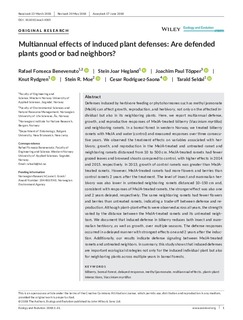| dc.description.abstract | Defenses induced by herbivore feeding or phytohormones such as methyl jasmonate (MeJA) can affect growth, reproduction, and herbivory, not only on the affected individual but also in its neighboring plants. Here, we report multiannual defense, growth, and reproductive responses of MeJA-treated
bilberry (Vaccinium myrtillus) and neighboring ramets. In a boreal forest in western Norway, we treated bilberry ramets with MeJA and water (control) and measured responses over three consecutive years. We observed the treatment effects on variables associated with herbivory, growth, and reproduction in the MeJA-treated and untreated ramet and neighboring ramets distanced from 10 to 500 cm. MeJA-treated ramets had fewer grazed leaves and browsed shoots compared to control, with higher effects in 2014 and 2015, respectively. In 2013, growth of control ramets was greater than MeJA-treated ramets. However, MeJA-treated ramets had more flowers and berries than control ramets 2 years after the treatment. The level of insect and mammalian herbivory was also lower in untreated neighboring ramets distanced 10–150 cm and, consistent with responses of MeJA-treated
ramets, the stronger effect was also one and 2 years delayed, respectively. The same neighboring ramets had fewer Flowers and berries than untreated ramets, indicating a trade-off between defense and reproduction.
Although plant–plant effects were observed across all years, the strength varied by the distance between the MeJA-treated ramets and its untreated neighbors. We document that induced defense in bilberry reduces both insect and mammalian herbivory, as well as growth, over multiple seasons. The defense responses occurred in a delayed manner with strongest effects one and 2 years after the induction.
Additionally, our results indicate defense signaling between MeJA-treated ramets and untreated neighbors. In summary, this study shows that induced defenses are important ecological strategies not only for the induced individual plant but also for neighboring plants across multiple years in boreal forests. | nb_NO |

